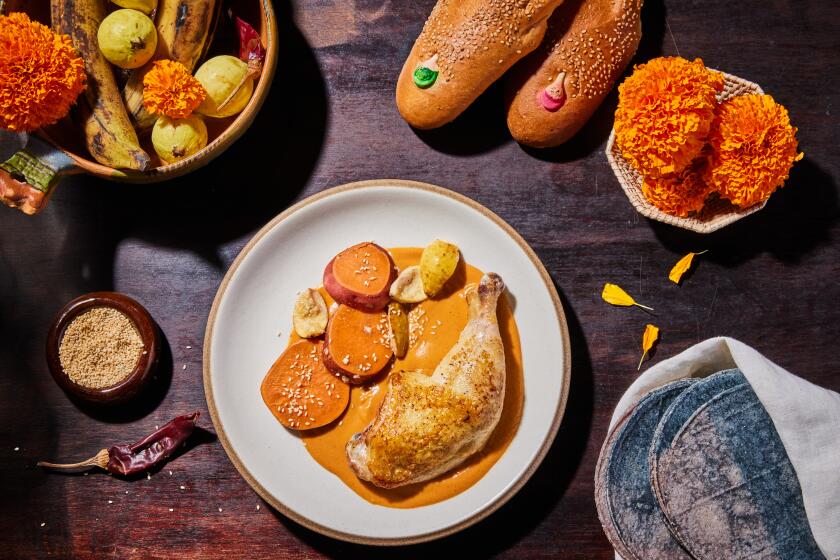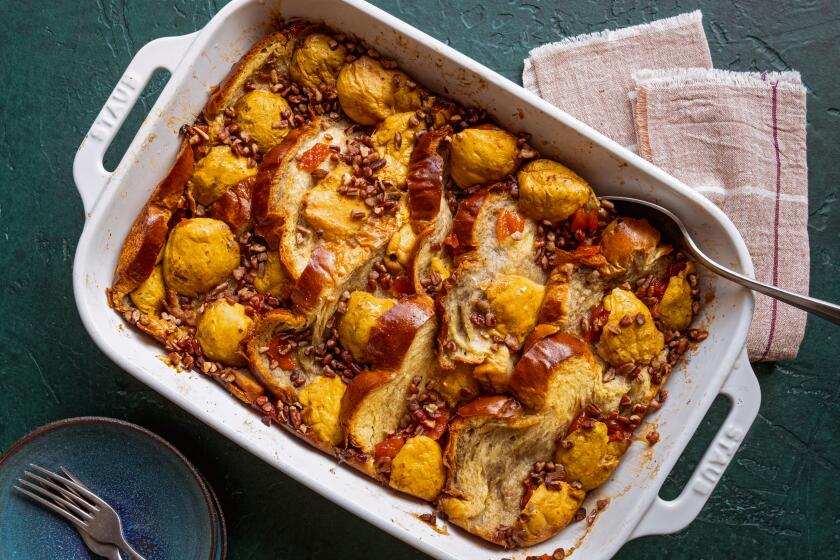
- Share via
- Día de Muertos is a holiday for cooking the favorite foods of your loved ones, departed or living.
- The dish mixiotes, often served for the holiday in Hidalgo, traditionally was wrapped and cooked in the outer skin of agave leaves, but parchment works.
- Make capirotada, a lush bread pudding of bread soaked in piloncillo syrup.
I started cooking for Día de Muertos after my grandfather Heriberto González Sánchez died in 2011. I made my first pan de muerto bread leavened with pulque, the pre-Hispanic beverage made from the fermented sap known as aguamiel, extracted from the maguey (agave) plant. The sour elixir came in a milk jug I purchased from a street vendor in the piñata district in downtown L.A. I set up a small altar on the kitchen table of our studio in Angelino Heights.
In observance of the holiday when souls return to their families to feast and celebrate (which traditionally falls on the first two days of November), I embrace the opportunity to sit with the memories of loved ones. It’s a chance to cook and gather their favorite foods: mole Poblano, corundas (triangular tamales wrapped in fresh corn husks from Michoacán), “sopa Maruchan” (Instant Top Ramen), chocolate, camote enmielado con leche (candied sweet potato with cold milk). It is believed that the souls partake in the feast before returning to the underworld, taking with them provisions for the entire year so they can return the next.
This vibrant fruit mole is for my abuelo Beto’s altar for Day of the Dead. It’s made with guava, plantains and chiles, inspired by my grandfather’s garden in the tropical paradise of Puerto Vallarta, Mexico.
I make my tropical mole with guavas, inspired by my abuelo’s garden in Puerto Vallarta, Mexico. I close my eyes when I take the first spoonful of the aromatic, golden-like-the-sun yellow sauce. I can see his smile. I can almost hear his voice.
This is just one of the dishes I prepare leading up to the sacred holiday, which is marked by the completion of the harvest for corn, Mexico’s predominant food crop and the most important symbol of cultural significance in Mexican identity.
1

2

3

4

1. Use parchment paper to wrap the marinated chicken and slices of fall squash. 2. Eat mixiotes from their own paper bundles, or add the chicken and its chile-tinged sauce to tortillas. 3. Capirotada, bread pudding soaked in piloncillo syrup, is baked with fresh guava, dried fruit and nuts. 4. Serve capirotada with whipped cream if you like.
Food is a starting place to celebrate your own Día de Muertos. Along with corn and squash, other seasonal foods native to Mexico, such as guava, tejocote (Mexican hawthorn) and tunas (prickly pear), play a significant role in the cultural legacy of the celebration. These native foods reclaim the Indigenous roots of the celebration. They help us reconnect to the culture and humanity of its people.
Día de Muertos is not just a holiday. It’s spiritual. It’s building an altar. It’s setting up a feast as an ofrenda, or offering. My Muertos feast is traditional to me. My abuelo grew up in a rancho in Río Grande, in the Mexican state of Zacatecas, where his family lived off the land, eating corn, squash, beans, chiles and nopales.
This year, I want to cook mixiotes, a traditional dish served during Muertos, particularly in Hidalgo and across the Altiplanicie region of northern and central Mexico (Estado de México, Tlaxcala, Puebla, Hidalgo and Querétaro).
Mixiotes de Pollo (Parchment-Wrapped Chicken)
Cooks make it with meats such as lamb, rabbit or chicken. The meat is marinated in a bright adobo made with dried chiles and vinegar. Traditionally, it’s wrapped in the thin film sourced from the stalks of maguey plants such as agave, and then steamed or cooked in a pit.
“Mixiote” is derived from a Nahuatl word and refers to both the material it’s wrapped in (xiotl, or the outer skin of an agave leaf) and the dish itself.
Parchment paper is now used instead, however, due to limited access to the endangered species of wild agave. Mixiotes catch your eye because of their looks: The packet of meat in adobo is like a bundled gift.
I top it with honeynut squash, but any squash will do, such as butternut or acorn. The parcel is tied tightly with kitchen twine and steamed for just 30 minutes, and it is meant to be unwrapped at the table.

I grew up in Puerto Vallarta, in Jalisco state, where guavas and tejocotes are plentiful and fill the mercados this time of year. The only capirotada, or bread pudding, I‘ve ever loved is the one from Jalisco, dotted with guava and pecans. I make mine with sweet egg bread such as pan de yema, challah or brioche.
The food I cook for Muertos holds well, prepared in advance and ready before my guests arrive. That way, I can shift my attention to placing photos of their loved ones on the community altar and gather with them to share stories.
Capirotada Tropical (Bread Pudding With Guava and Apricots)
And preparing the capirotada ahead of time allows the bread to absorb the spiced piloncillo syrup. Put it in the oven while you place a plate of food on the altar for your muertitos to feast on. They will be so happy that you cooked for them. You are welcome to enjoy the feast with them, of course.
The food in your ofrenda might look different than mine. That is a beautiful way to acknowledge all the traditions closest to your roots and mine. Ask yourself, what do you want to share with the people who come to honor their ancestors? What dishes celebrate yours? Bring them to the altar.
More to Read
Eat your way across L.A.
Get our weekly Tasting Notes newsletter for reviews, news and more.
You may occasionally receive promotional content from the Los Angeles Times.













